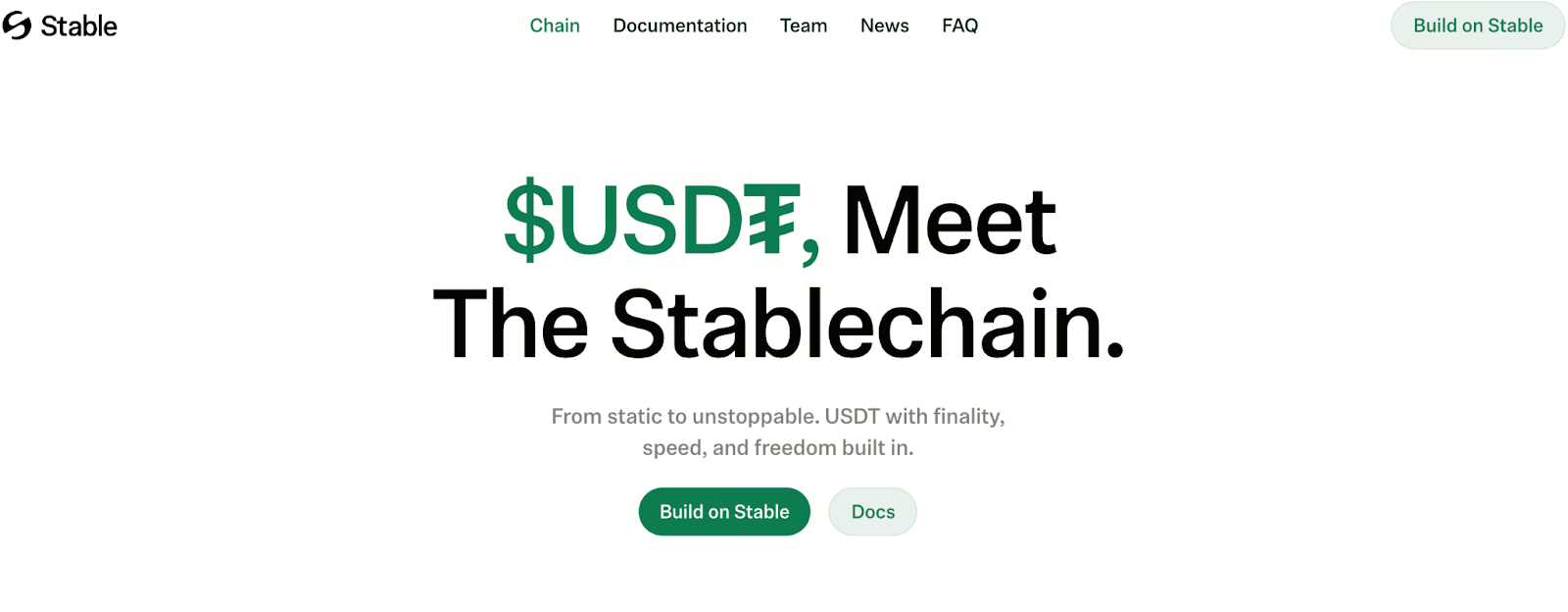Stable Blockchain for Stablecoin Payments Unveiled
What Is the Stable Project?

Image source: https://www.stable.xyz/
Within the blockchain sector, “stablecoins” are cryptocurrencies pegged to fiat currencies (such as the U.S. dollar), designed to reduce price volatility. Stable is a Layer 1 blockchain project specializing in stablecoin payments. Its mission is to create a fast, low-cost, high-throughput payment network centered around stablecoins—especially Tether (USDT). Based on project documentation, Stable leverages USDT’s liquidity advantages to pursue its vision of making stablecoins the go-to payment tool.
Supporting Forces: Tether and the Stablecoin Ecosystem
Stable’s background is significant: USDT, issued by Tether Limited, is one of the largest USD-pegged stablecoins and leads the crypto market in both circulation and use cases. Stable taps into the issuer’s reputation and network, offering potential advantages for payment infrastructure development. On a broader scale, stablecoin payments are gaining ground as a mainstream trend—according to McKinsey, stablecoins as “tokenized cash” are enabling the next generation of payment architectures. Stable is therefore not a standalone new chain, but part of a dynamic sector where stablecoins, payments, and foundational blockchains converge.
What Is the Second “Deposit Event”? How Does It Work?
Stable recently announced the launch of Pre-Deposit Phase 2 next week. This event allows users to deposit stablecoins (primarily USDT) into designated smart contracts, with future eligibility for ecosystem incentives or token rewards. Phase 1 set a deposit cap of $825 million, which was reached rapidly.
For Phase 2, the project will implement these mechanisms:
- Fixed total deposit cap;
- Per-wallet (address) deposit limits to prevent large holders (“whales”) from dominating;
- Wallets must meet eligibility requirements (such as identity verification/single wallet restrictions) to ensure greater fairness.
If you’re new and hold USDT, this could be a chance to enter the project ecosystem, but it’s important to understand the rules and timing.
New Mechanism Highlights: Who Is It For, and What’s Different?
Compared to Phase 1, Phase 2 features improved fairness and lower barriers to entry. The first round filled within minutes, sparking community concerns about “insider access” and “whale advantage.” The new mechanism includes per-user wallet caps, overall caps, and identity-verification rules, giving retail participants (small and mid-sized holders) a better shot at joining. For newcomers, this marks a shift from “dominated by major players” to “open to broader participation.” Still, be aware that there may be discrepancies between announced rules and how they’re enforced, so always check official announcements, contract addresses, and wallet requirements before taking part.
Risk Notice and Advice for New Participants
While Stable offers many appealing features, new users should pay special attention to:
- This event is not investment advice: Pre-deposit activities don’t guarantee immediate token listings or trading; project progress, token value, and smart contract security remain uncertain.
- Compliance and regulatory risk: The stablecoin and payment blockchain fields are facing tighter regulation, such as new U.S. laws like the “Genius Act.”
- Participation fairness is still debated: Despite fairer rules for Phase 2, concerns persist about potential “whale-first” scenarios.
- Wallet security and contract verification: Always use official channels to verify contract addresses and guard against phishing or fraudulent projects.
- Exercise caution with participation amounts: Avoid using major funds for early-stage activities—consider this a way to “test the waters” or learn about the project.
Summary: Why Should You Watch This?
In summary, Stable stands out for several reasons:
- It combines USDT’s large-scale liquidity with the foundational value of next-generation payment infrastructure.
- The second deposit event gives newcomers a pathway to participate in early ecosystem development.
- In the evolving stablecoin payments sector, transaction efficiency, blockchain optimization, and low-cost transfers are key differentiators—and Stable is advancing in these areas.
If you’re interested in crypto, blockchain payment infrastructure, or the stablecoin ecosystem, keep a close eye on Stable’s official updates, rule changes, and contract address announcements. For new users, focus on learning and participating with small amounts—don’t chase hype blindly.
Related Articles

2025 BTC Price Prediction: BTC Trend Forecast Based on Technical and Macroeconomic Data

Flare Crypto Explained: What Is Flare Network and Why It Matters in 2025

Pi Coin Transaction Guide: How to Transfer to Gate.com

How to Use a Crypto Whale Tracker: Top Tool Recommendation for 2025 to Follow Whale Moves

What is N2: An AI-Driven Layer 2 Solution


